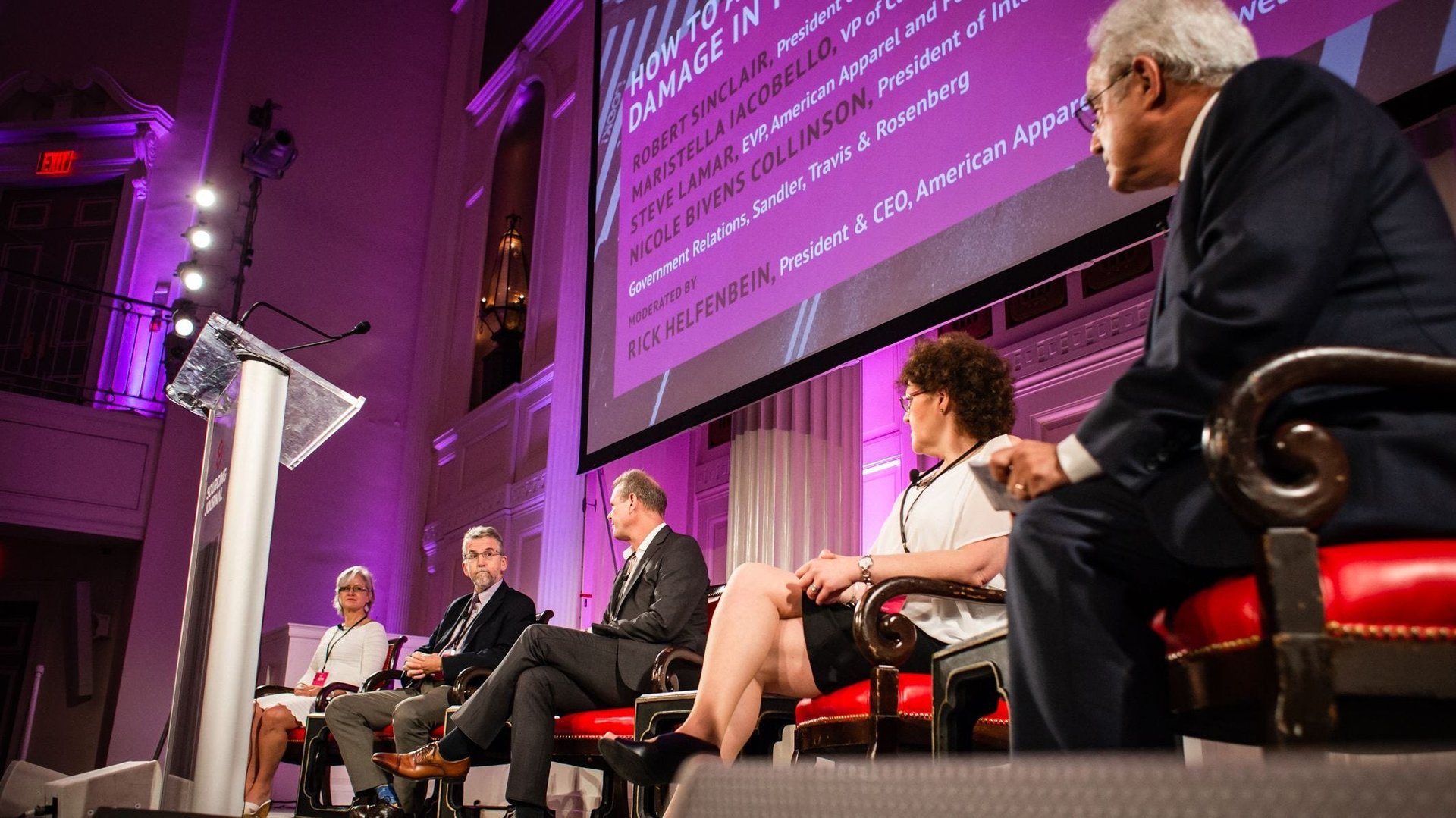The US apparel industry is bracing for a decades-long trade war with China
To those hoping a détente is at hand in the escalating US-China trade war, experts at an Oct. 11 summit had a blunt message: Settle in. This war is just getting started.


To those hoping a détente is at hand in the escalating US-China trade war, experts at an Oct. 11 summit had a blunt message: Settle in. This war is just getting started.
“I believe [Chinese president] Xi Jinping is not going to back down, and I don’t believe the US is going to back down,” said Nicole Bivens Collinson, president of international trade and government relations at Sandler, Travis & Rosenberg, which bills itself as the world’s largest law firm dedicated to international trade, customs, and exports. “We’re stuck in this, I would say, 20 years. I don’t see any way out.”
American clothing and footwear brands are anxiously watching the tit-for-tat exchange in tariffs between the US and China. That’s because the US imports nearly all of its clothing and footwear, and China is by far the largest source. According to data from the World Bank, in 2016—the year with the most recent figures available—about 36% of US imports of textiles and clothes came from China, and approximately 60% of footwear. The US already places some of its highest tariffs on clothing and footwear, so the industry is especially sensitive about the prospect of more duties.
The summit, hosted by the trade publication Sourcing Journal, included a panel on tariffs and how brands should consider adjusting their supply chains. While the tariffs have been framed by the Trump administration as punishment for China stealing the intellectual property of US companies, they also appear to be part of a broader agenda to check China’s growing sway in the world and keep the US competitive against it.
The general consensus among experts and industry representatives at the conference was that these escalating tariffs are not temporary, with the caveat that the Trump administration is inherently unpredictable, so that could change.
“It’s about the trade deficit, it’s about rebalancing the relationship that the US has with China, perhaps disentangling the way the US economy and the Chinese economy relate to each other,” said Steve Lamar, executive vice president of the American Apparel and Footwear Association. “Tariffs are simply pressure that the president is putting on China to encourage them to talk, to have them talk on his terms. Tariffs, we believe, are a long-term thing.”
It’s worth noting that the tariffs have so far increased the US trade deficit with China.
Trump has already put a 10% tariff on a large number of Chinese goods, including certain accessories and footwear. The tariff is set to climb to 25% if China retaliates. Clothing has been spared thus far, but with nobody backing down, higher tariffs on more and more Chinese products, including clothing, look inevitable.
Proponents of Trump’s tariffs argue they’ll teach China a needed lesson and force it to crack down on copying and counterfeit products. But in the process, because of the way tariffs get baked into the final price shoppers pay for imported goods, the tariffs will raise prices for US consumers. And it’s foolish to think that China will cease infringing on the intellectual property of US firms, the panelists said.
Indeed, China has given every indication it will keep pushing back. It already announced, for instance, that it will increase export tax rebates for Chinese firms to reduce the pain of a trade war. It could also resort to ”non-tariff barriers,” Collinson predicted, since the trade imbalance means it only imports so many American goods it can hit with duties. It may do things like delay licenses, certifications, and inspections for US firms in the country, keeping them from being able to do business or export the products they’ve manufactured.
This battle of wills between the world’s two largest economies will likely continue far beyond the present political moment. Even if a new administration takes over in the US, the country won’t be able to back down without appearing to sanction China’s behavior. China’s Xi, meanwhile, has amassed enough power at home to remain president for life, and experts believe he’ll do anything he can To avoid looking weak (paywall) in a confrontation with the US.
As evidence grows that this is the new reality, many brands may have to rethink their supply chains. ”I think ultimately these tariffs, specifically the US part of it, are going to fundamentally transform supply chain solutions, supply chain strategies,” said Robert Sinclair, president of global supply chain at Li & Fung, a large sourcing and logistics firm.
Many of Li & Fung’s clients started moving out of China some years ago as prices rose there, Sinclair said. The US-China dispute is going to see even more manufacturing head to cheaper nearby countries, though the alternatives to China, such as Bangladesh, Vietnam, and Cambodia, don’t have the capacity or infrastructure to take in all the manufacturing the trade war could displace.
While brands figure out how to respond, their profits may take a hit—in the fashion trade as they have in other industries. Already, Ford CEO Jim Hackett said Trump’s tariffs on metals such as steel and aluminum have cost the car company $1 billion in profits. “What we’re urging our administration to do—where we’re in China and in Europe—we say, you need to come to agreement quickly,” he told Bloomberg (paywall). That’s looking less and less likely.